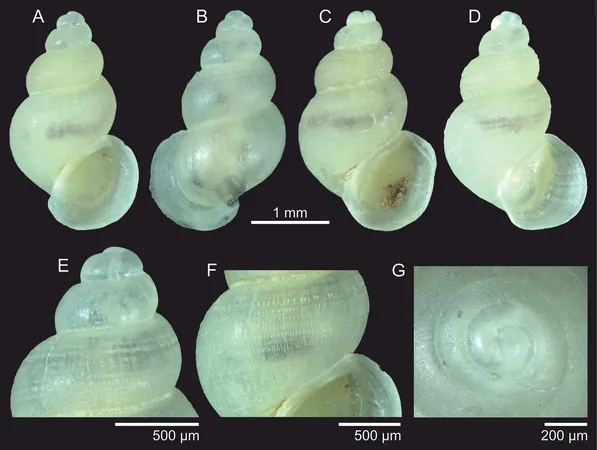
Two New Snail Species Bring a Touch of Tolkien Magic to Brazilian Ecosystems
2024-11-11
Author: Jia
Two New Snail Species Bring a Touch of Tolkien Magic to Brazilian Ecosystems
In an enchanting twist of nature and literature, researchers have unveiled two newly discovered freshwater snail species from Brazil, naming them after beloved characters from J.R.R. Tolkien's "The Lord of the Rings." This fascinating revelation was detailed in the academic journal, *Zoosystematics and Evolution*, showcasing the intersection of science and storytelling.
Names and Symbolism
The new species, *Idiopyrgus eowynae* and *Idiopyrgus meriadoci*, pay homage to the fearless Éowyn and the brave Meriadoc Brandybuck. In their paper, the authors vividly describe Éowyn as a symbol of courage and resilience, fighting against the corrupt Gríma Wormtongue and the fearsome Witch-king of Angmar. Meanwhile, Merry is celebrated not only for his role in the epic battles but also as a champion of nature, urging the Ents into action to confront the malevolent Saruman, thus preserving the beauty of Fangorn Forest.
Discovery Location and Habitat
These remarkable snails were found nestled within a unique limestone cave in the Serra do Ramalho karst area of Bahia, northeastern Brazil. They belong to the Tomichiidae family, historically known for their presence in surface freshwater ecosystems. However, this discovery sheds light on their intriguing adaptation to underground habitats, a feat that speaks volumes about the resilience of life.
Distinctive Features and Adaptations
Among their distinctive features are periostracal hairs—spiky structures on their shells that are rarely seen among Brazilian freshwater snails. These cave dwellers have also adapted to their dark environment by evolving reduced pigmentation, fragile shells, and a petite size—characteristics that further underscore their unique ecological niche.
Conservation Concerns
The Gruna do Pedro Cassiano cave, home to these newly named species, is a fragile environment currently facing dire threats from water extraction, deforestation, and the increasingly pressing effects of climate change. Given their restricted habitat and the human-induced dangers looming over their ecosystem, the researchers urge a classification of these snails as vulnerable. Their findings serve as a clarion call for heightened awareness and conservation efforts to protect Brazil's subterranean biodiversity.
Remarks from the Lead Researcher
Dr. Rodrigo B. Salvador, the lead author from the Finnish Museum of Natural History, explained his whimsical naming convention, stating, "I love infusing pop culture references—be it from books, games, or comics—into species names. This trend has historical roots, but now it brings new life and relevance to taxonomy." He emphasized that the tradition of invoking mythology and literature for species names is alive and well, allowing us to connect ancient tales to modern discoveries.
Conclusion
With every new species discovered and named, we celebrate not only the wonders of the natural world but also the narratives that inspire us. As we confront the challenges facing these unique ecosystems, let us hope for a future where both nature and its stories thrive in harmony.



 Brasil (PT)
Brasil (PT)
 Canada (EN)
Canada (EN)
 Chile (ES)
Chile (ES)
 España (ES)
España (ES)
 France (FR)
France (FR)
 Hong Kong (EN)
Hong Kong (EN)
 Italia (IT)
Italia (IT)
 日本 (JA)
日本 (JA)
 Magyarország (HU)
Magyarország (HU)
 Norge (NO)
Norge (NO)
 Polska (PL)
Polska (PL)
 Schweiz (DE)
Schweiz (DE)
 Singapore (EN)
Singapore (EN)
 Sverige (SV)
Sverige (SV)
 Suomi (FI)
Suomi (FI)
 Türkiye (TR)
Türkiye (TR)